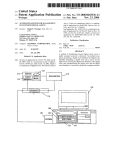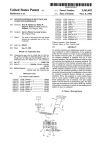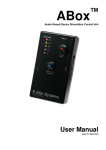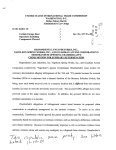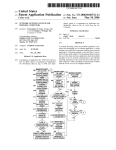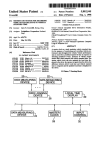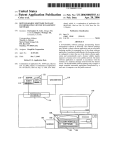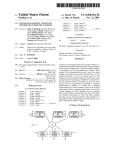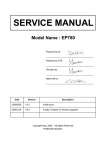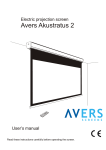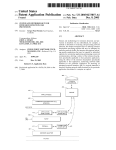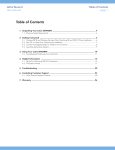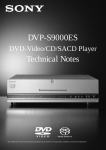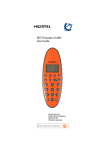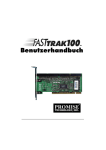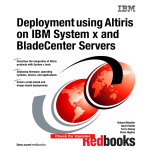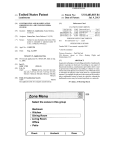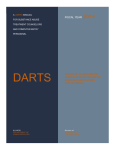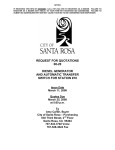Download Automated system for management of licensed software
Transcript
‘ United States Patent [19] US005790664A Patent Number: [45] Date of Patent: Coley et a]. Elan Computer Group. Inc.. “Elan License Manager Tech nical Overview”. pp. 1-10. (1995). [75] Inventors: Christopher D. Coley. Morgan Hill; GLOBEtrotter Software. Inc.. “FLEX/m End User Manual”. Ralph E. Wesinger, J r.. Livermore. Chapters 1-7. (1996). Primary Examiner—-Salvatore Cangialosi both of Calif. Attomey, Agent, or Firm-McDonnell Boehnen Hulbert & [73] Assignee: Network Engineering Software, Inc.. Berghoff San Jose. Calif. [57] [21] Appl. No.: 607,081 [51] for determining whether the software is validly licensed and enabling or disabling the software accordingly. Exemplary Int (:1.6 ...................................................... .. H04L 9/00 380/4 systems involve attaching a licensing system module to a software application. Records of valid licenses are stored in Field of Search ......................... .. 380/4. 25; 3951712 [56] ABSTRACT Methods and apparatuses are disclosed for providing a system for automatically tracking use of a software and also Feb. 26, 1996 [52] US. Cl. [58] Aug. 4, 1998 OTHER PUBLICATIONS [54] AUTOMATED SYSTEM FOR MANAGEMENT OF LICENSED SOFTWARE [22] Filed: 5,790,664 [11] the database maintained by the software provider. The licensing system module transparently forms a license record inquiry message. The message is transparently sent to References Cited U.S. PATENT DOCUMENTS the database over a public network. such as the Internet. to 4,888,798 12/1989 Earnest ........ .. 5,023,907 6/1991 Johnson et al. 5,138,712 811992 Corbin ........ .. 5,204,897 4/1993 5,260,999 Wyman 380/4 determine whether a valid license record exists in the ..... .. 380/4 database for the software application. The database forms 395/712 . .. .. . . . . . .. 11/1993 Wyman ....... .. cation can then be appropriately enabled or disabled by the 395/712 5,438,508 5,495,411 8/1995 Wyman 2/1996 Anauda 380/4 380/4 5,548,645 8/1996 Ananda ..... .. 380/4 5,579,222 11/1996 Baius et a1. 5/1997 preted by the licensing system module. The software appli 380/4 5,375,206 12/1994 Howter et a1. 5,629,980 and returns an appropriate response message that is inter 380/4 licensing system module. The receipt of the license record inquiry can be recorded in the database to monitor software use. 395/712 25 Claims, 7 Drawing Sheets Ste?k et a1. .............................. .. 380/4 200 [BRING UP CLIENT‘ ' APPLICATION , A A K527 PROMPT USER} 226 TO TAKE 202 M ID IN CLIENT MODULE 00 NOT 1‘ * ENABLE. OR I 30 DIFSABLEE APPLICATON APPLICATION NO MEsSAGE 232 /ooEsTHk\ / YES / LICENSE ID FIELD 21o SENFQEQAJEST M mg \ ~~ comma LICENSE my‘ SA T, 'REcElvE ‘ / \INPORMA/ON _ ENABLE SOFTWOARE so TWA 2°9 I~ RECORD LICENSE ACTION 204 CONNECTION T0 LICENSE SERVER OVER INTERNET 206 I APPROPRIATE 1 234 / \/ 212 REQUEST MESSAGE, FORM QUERY 224 213 RECORD AUDIT ID m RESPONSE INFORMATION MESSAGE ANALYZE LICENSE PERFORM 222 CLOSE INTERNET QUERY 0F 214 4 CONNECTION DATABASE ‘_ __ .// IS ‘ \ 2,6 ,/ (_ 4> INSTFLT mo UOENSE ID FIELD OF \QORRTEOSEEID'N9 NO \. " 21a “YES INSERT LICENSE REcoRb RESPONSE MESSAGE 22 RET LOCATION POINTER INTO LICENSE ID FIELD OF RESPONSE MESSAGE TO RESPONSE MESSAGE CLIENT MODULE NO US. Patent Aug. 4, 1998 5,790,664 Sheet 1 of 7 02 U ~EU; / //2:m2 _m2 _ U W.H.N2/ /m‘,5E2m6iu w: ,B2ER5/028 o: / m$Z5E?wmg mE/ w hmz 2: US. Patent Sheet 2 Of 7 Aug. 4, 1998 200 BRING PP UP I ACLIENT® l N A L 0+ T O 227 PROMPT USER 202 "MATE LICENSE VALIDITY CHECK + FORM T DO NOT ENABLE» 0R CONNECTlON 208 ENABLE SOFTWOARE SOFTWARE APPLICATON 232 DOES THE LICENSE IO FIELD 31' RT TIMER CONTAIN LICENSE ID NFORMATIO RECEIVE REQUEST 2 4 2 2 MESSAGE, FORM QUERY 2 ANALYZE LICENSE I RECORD AUDIT 3° APPLICATION MESSAGE 213 RECORD LICENSE ID IN CLIENT MODULE D'SABLE FORM LICENSE INQUIRY REQUEST MESSAGE I 21o SEND REQUEST 1 228 TO TAKE APPROPRIATE ACTION 204 CONNECTION TO LICENSE SERVER OvER INTERNET ‘ 206 CONF'RM 5,790,664 ID IN _ RESPONSE INFORMATION MESSAGE I PERFORM 214 QUERY OF 222 CLOSE INTERNET‘_ DATABASE CONNECTION '8 THERE A INSERT NULL 216 INTO LICENSE IO LICENSE RECORD FIELD OF CORRESPONDING RESPONSE MESSAGE 220 INSERT LICENSE RECORD LOCATION POINTER INTO LICENSE ID FIELD OF RESPONSE MESSAGE I RETURN RESPONSE __ MESSAGE TO CLIENT MODULE |=|GURE 2 US. Patent wEDGE Aug. 4, 1998 Sheet 4 of 7 5,790,664 5 .790.664 2 1 prompt may be a security system asking the user to enter the AUTOMATED SYSTEM FOR MANAGEMENT OF LICENSED SOFTWARE BACKGROUND The present invention relates to software licensing. and in particular to a system for automated monitoring and man agement of licensed software. It is well known that software is not purchased. but only licensed for use. Software. unlike manufactured products. can be freely copied and distributed. Hence. software pro viders are largely limited in their choice of control means. Unfortunately, a software license is merely a legal mechanism. and can not literally prevent illicit copying of proprietary software. A typical software license grants a permit to use the licensed software application on a particu lar machine and. perhaps. the generation of backup copies serial number and/or a codeword to enable the software. The codeword may be a word appearing at prompt-designated locations in a user manual. This security scheme operates on the premise that a pirate will not ordinarily have a copy of the user manual. After the software is up and running. it may periodically prompt the user to re-enable the software by entering a different codeword appearing at varying locations in the user manual. This scheme is subverted by copying the manual and registration number. An on screen registration/enablement process may involve writing the registration number to disk. This is only possible with ?oppy disks as CD-ROMS are. at present. a 15 for personal use. A software license provides a software provider with a legal instrument against impermissible use of licensed software. However there remains no effective mechanism for preventing or monitoring illicit copying or illegal proliferation in the ?rst place. Hence. software pro viders mu st rely on the public to not pirate software. and rely on their licensees to abstain from furnishing copies of 20 software to friends or others. A signi?cant amount of soft ware piracy occurs in commercial settings. Commercial licensees are usually vigilant about license compliance. than once. Furthermore. if ?rst run registration enablement 25 However. even the most attentive MIS manager ees from copying software off of company machines for their personal use. As a result of illicit copying. software software application. Such a mechanism may be used where providers must adjust their prices. forcing legitimate buyers determining how widely software is copied. More a software provider wants to supply. for example. a 30-day demonstration version of a software application for user evaluation. If the user decides to purchase a license follow ing the evaluation period. the user may contact the software 35 speci?cally. there is no mechanism by which to monitor the proliferation and use of software. copied or otherwise. provider and supply payment information. Following approval (e.g.. credit card) or receipt (i.e.. check) of the payment. the software provider may supply the user with a regular copy of the software. or provide instructions or a codeword to disarm or reset the date/time checking mecha Statistics regarding the use of legitimately purchased soft ware also remains unknown to software providers and nisrn. In operation. a date/time checking mechanism records a vendors. Despite sales data. purchased software may be found ineffective by users and sit. unused. on hard drives. Consequently. software providers may not have a ?rm date/time stamp when a software application is ?rst brought up. Alternatively. or in addition. the date/time mechanism may start a timer when the application is brought up. The understanding of how their products are being received by users. Whether used or not. most proprietary software con date/time stamp is compared with the system date/time information maintained by the computer to determine if the software application is to be disabled. To subvert such a tains some security mechanism and/or registration mecha nism. There are a number of schemes designed to prevent software from being copied. or to make use of copied software unduly burdensome. These schemes. however. are largely ine?‘ective. complex. and add to development costs. Furthermore. for every protection scheme devised by programmers. there are hackers who will diligently go about undermining them. A ?rst line of defense is to encourage legitimate users to register their licensed software. is required. copiers can simply copy the software repeatedly prior to registering the original copy. Another security technique is to enable a software appli cation for a de?ned period of time. This usually involves incorporating a date/time checking mechanism into the (Management Information Systems) cannot prevent employ to pay higher prices to offset revenue losses. Although the estimates for losses due to piracy are estimated in the billions of US. dollars. such estimates remain mere projections. This is because there way of largely read-only medium. If the disk is used again to load the software application. the software may prompt the user with a warning that the software has already been loaded (e.g.. “IS LOADING OF THIS SOFTWARE PERMITTED‘? RECORDS INDICATE THAT THIS SOFTWARE HAS ALREADY BEEN LOADED. YOU MAY BE IN VIOLA TION OF YOUR LICENSE AGREEMENT”). However. reloading of software may be normal in the event of hard disk failure. Consequently. software providers cannot feasi bly prevent the software application from being loaded more system. users have been lcnown to reset the system date and 50 system time to prevent expiration. In response. some soft ware providers have resorted to writing complex code schemes to disable the software in the event that the system date is tampered with. Such a security mechanism is often used to control licensed software used in a commercial setting. 55 Software sold for use in a commercial or institutional Registration of software provides a software provider setting is frequently licensed for a prede?ned period of time. with a record of a valid license. Registration typically involves ?lling out and mailing a registration card that is provided in an off-the-shelf software package. A user may be asked to write in the serial number of the software set. along with other pertinent information. The defense mechanism in When such software is used on desktop computers. such computers are typically networked. The networked comput ers are usually connected to a ?le server. which ?le server may itself be tended by a computer management system that monitors and controls various ?le server groups. The ?le server computers act as a cenn'al location at which the desktop computers in the ?le server group can access ?les and applications. The ?le server also may facilitate the registration. albeit weak. is that a software provider will only render assistance and support to properly registered users. That is. a software provider will refuse to grant assistance to a user unless the user has properly registered their software. The registration process also may involve responding to prompts generated by the software when it is ?rst run. The 65 control of licensed software on the desktop computers. This occurs in the situation where the commercial software license is a so-called “?oating license." 5,790,664 4 3 SUNINIARY Commercial software licenses for operating a plurality of desktop computers normally are of two varieties: “?xed” or The present invention addresses the foregoing problems by providing a system for automatically determining “?oating.” A ?xed license permits a software application to run on certain designated computers (e.g.. computer num whether a software application is licensed. In accordance with the invention. a generic licensing module. or “client module." is provided that a software provider can attach to a software application. A software application having a bers one through ?ve. in a ten computer ?le server group. are designated for the licensed software application). A ?oating license permits a certain number of applications to run on any number of computers at a given time. So an application operating under a ?oating license may be allowed to simul client module attached thereto is hereinafter referred to as a “client application.” In accordance with preferred embodi taneously run on no more than ten of twenty computers in a ments of the invention. a client application loaded on a computer having access to a public network. such as the network at any given time. Licensing management software is maintained in the network ?le server to monitor the number of ?oating licenses being used. Commercial software is prone to installation interruptions as it almost always requires involved enablement proce dures. In accordance with regular industry practices. com mercial software applications are ordinarily enabled follow ing their installation by contacting the software provider for enablement instructions and/or enabling codes. This process is rarely instantaneous. The software provider usually con Internet. automatically reports to a computer maintained by a software provider. The client module is a program. application. or like composition of code that is preferably nested in a compiled version of a software application (i.e.. to form a client application). However. the client module can. in alternative embodiments of the invention. be attached to a previously compiled software application. Whether it is 20 ?rms that the software license is proper and paid for before faxing. e-mailing. or even using regular mail. to provide a set of enabling instructions. enabling codes. or disk(s) with which to bring the application up. Consequently. the soft referring to a program nested in. or attached to a software application. the term client module is used throughout the present disclosure. A client module utilizes the public network as a means to transparently send license inquiry request messages to. and receive license inquiry response messages from. a license ware remains disabled until additional instructions are sup 25 server maintained by a software provider. The license server plied and followed. which are usually sent only after an has a database on which license information. or records. are stored. The license server also can record information con enablement request is approved. Management of ?oating licenses on networked computers tained in license inquiry request messages. and thereby audit involves two control software components: an application tion is nested within an application running on a desktop use of client applications. The license record can identify a license in accordance with a hardware address. or hardware identifier of the computer. such as an IP address. computm'. The authentication portion is a code module Operation of an exemplary system incorporating the portion. and an authenticator portion. The application por contained in the ?le server that monitors and authorizes invention involves the client module in a client application applications running on the desktop computers. When a user 35 generating inquiries that are sent to the license server in the attempts to open the application software. the application context of an Internet communication session. The license portion code communicates with the authenticator code server responds to the inquiry by investigating its database module to check to see if a ?oating license is available. If the to determine whether a corresponding license record is present. The license server then forms an appropriate response message that is sent back to the client module. If it is determined that the client application is not licensed (i.e.. the database does not contain a corresponding license record). the response sent by the licensing server does not allow the client application to be enabled. If the client application is licensed (i.e.. the database contains a record of a license). the response can allow the client application to be enabled. or re-enabled. In sum. the client application must be maximum number of floating licenses are already being used. the software application is not allowed to open. Licensing control software also may be used to monitor de?ned term licenses to disable software in networked machines after license expiration. If a commercial license expires. the software may be disabled, midstream. preventing users from completing projects. Re-enablement requires contacting the software 45 provider to purchase an additional license or extension. This may require re-execution of enablement procedures with enabled for it to properly operate. Communication between the computer and the licensing server is generally transpar new instructions or codes. Hence. it may take some time before the software application is up and running again. which situation can seriously inconvenience users. 50 ent to a user. That is. the client module automatically forms a connection with the license server. sends a message. and receives a response. all without user input or noti?cation. The common shortcoming shared by all licensed software. is that it requires some form of manual interven tion for registration. enablement. and/or re-enablement. Manual intervention is cumbersome and can render software useless until it is enabled or re-enabled. The paramount issue Altm'natively. an exemplary embodiment of the invention SS can be used to monitor use of client applications. Operation of an exemplary system incorporating the invention for is. however, that software providers have no mechanism for monitoring client application use involves using the client module in the client application to generate messages that monitoring and controlling the actual use. whether legiti mate or illicit. of their product. Proprietary software is misappropriated on a global scale causing massive losses to are sent to the licensing server. Such messages can be sent over any public network to which a user computer. upon software providers. which losses are inevitably passed on to example, a message can be sent to the license server in the context of an Internet communication session. The license which the client application is loaded. is connected. For legitimate licensees. What is needed is a licensing system that allows software server tracks, or audits. the use of client applications by use to be monitored in an automated fashion. without user recording pertinent information contained in a message input. Moreover. a software licensing system is needed that permits a software provider to transparently control the use of licensed software. 65 generated by a client module. A database can be used to store the information. A software provider or vendor can access recorded information stored in the database to generate 5 .790.664 5 6 client application use reports. Such an auditing system can be a part. or a function of. a system for enabling. validating generic. That is. client modules in the desktop computers and client components in each of the network level com puters are substantially similar. Agent components in the and/or disabling licensed software (i.e.. client applications). licensing modules and the agent module in the license server also are substantially similar. The cache components of the When con?gured as such. audit data can be derived from license inquiry request messages. Furthermore. the license licensing modules are used to store information that de?nes the structure of license records. Any client can communicate record database in the license server can be used to store the collected audit data. Alternatively. a separate database can be used. with any agent and vice versa. This arrangement facilitates network con?guration ?exibility. In a personal computer setting. an exemplary process in Operation of an exemplary system incorporating the accordance with the invention may involve utilizing a invention in the network environment involves a client modem. or like device. in the computer. The client module module in a client application forming and communicating generates and sends a license validity inquiry request mes a license validity inquiry request message upstream. An sage to a regional or central license server maintained by the software provider. The license server contains an agent agent component in a nearest upstream licensing module module for communicating with the client module and a receives the request. The licensing module checks its cache 15 database containing license records. The database in the to determine if a license record exists corresponding to the license server is checked to see if a valid license record request. The licensing module can then respond with an exists for the requesting client application and computer. If appropriate message. If the license information is not found so. a message is transmitted back that allows enablement or at that level. the licensing module can forward the request re-enablement of the client application. The licensing server upstream to determine if the license is of record in an also can record information corresponding to the request in upstream cache. This may continue up to the license server. the database containing the license records. or in a different When and if a license record is found. the information is database. copied into the cache of the licensing module nearest to the If a license record is not found. the client application is not computer originating the request for future reference. In enabled. A menu can be presented asking whether the user accordance with another aspect of systems incorporating the would like to purchase a license. and thus enable the 25 software. The menu may direct a user to a Web homepage invention. the licensing modules periodically communicate where a license can be purchased. automatically open a session to such a homepage. or provide a telephone number maintain currency of their cached license records. By doing upstream to fetch license information in order to revise and so. a validity request can be addressed by a nearest upstream of a sales representative or automated operator. Optionally. the user can initiate a demonstration mode of operation to agent. Furthermore. periodic checking can permit manage evaluate the client application. ment of request message tra?ic on the license server. In a commercial or institutional computer environment In accordance with an exemplary embodiment of the (i.e.. networked computers). a licensing system in accor dance with exemplary embodiments of the invention can involve a hierarchical arrangement of licensing modules arranged between client application(s) and a license server. At the desktop computer level. a client module monitors invention. license information is organized in class and sub-class designations. License information maintained on 35 the license server covers blocks of underlying computers rather than the individual desktop computers themselves. This provides for efficient communication of license infor one. or more. software applications on the desktop com mation between the license server. licensing modules. and puter. Computers. such as ?le servers. residing at each level desktop computers. of the network. between the desktop computers and the license server. contain licensing modules. Licensing mod environment. systems incorporating the present invention ules include an agent component for communicating with a downstream client. a cache component for interim storage of license information. and a client component for communi without signi?cant delay. Software applications operating in cating with an upstream agent. Operation in an exemplary process involves the client module in a desktop computer communicating upstream Whether used in a personal or commercial computing allow client software to be enabled or re-enabled at any time accordance with the present invention can be installed on 45 any computer in the world having access to a public network. such as the Internet. If so desired. a client appli cation can be configured to not operate unless it receives acknowledgment of the presence of a valid license record. As the use of computers expands globally. a licensing with an agent component in a licensing module. A client component in that licensing module communicates upstream system in accordance with the present invention can ensure that a client application operating on any computer in the world is properly licensed. In addition. in a personal or network computing with an agent component in a next licensing module. whose client component. in turn. communicates with a next upstream agent. and so on. This arrangement is continued upward to converge on a license server which contains an agent module. However. the license server is maintained by environment. systems incorporating the present invention the software provider. Consequently. the uppermost licens ing module in the institutional network communicates with $5 can be used to monitor client application use. Such a system the license server by initiating a connection over a public network. such as the Internet. License enablement informa inquiry requests messages that are received at the license server. Client application use. and corresponding details. can be recorded when the client module sends license inquiry request messages back to the license server. Alternatively. the system can be used in an audit-only mode whereby the can operate by recording information from license validity tion is supplied to the upper-most licensing module by the license server. which information is propagated back down stream via the licensing modules. The cache components in the licensing modules can be used to store license records so that license inquiries can be addressed without having to forward the validation inquiry request messages to the license server. In a preferred embodiment of the invention. as applied in a network environment. the client and agent elements are client applications report relevant information back to the license server. but do not require an enabling response message to continue operating. As the use of computers 65 expands globally. a licensing system in accordance with the present invention can assist in tracking client application use and proliferation. 5.790.664 7 8 Preferred embodiments of the present invention take advantage of the fact that an increasing number of In accordance with an exemplary embodiment of the invention. the client module 108 automatically initiates a process to determine whether the software application 102 is validly licensed. This can happen each time the client computers. and computer networks. have direct access to the Internet. Systems in accordance with the present invention can utilize the Internet as the medium over which license application 103 is brought up. The licensing module 108 validity inquiry request inquiries and their corresponding operates transparently and utilizes the modem 106 to form a connection with the licensing server 110. Once the connec tion is made. the client module 108 sends a license validity inquiry request message to the license server 110. The agent module 114 receives the request and queries the database responses are transmitted. In accordance with exemplary embodiments of the invention. if a client application does not receive enablement information. the client application is not enabled. or is disabled. Hence. any software application that contains a client module accordance with the invention. can be auto matically enabled. or disabled. Furthermore. use of client module equipped applications can be tracked. Such a system allows software to be freely distributed while ensuring that 112 to determine whether a license record exists that corre sponds to the client application 103 and computer 100. The license server 110 also can record relevant information contained in the license validity inquiry request message to 15 a license is taken for its use. or at the very least. ensuring that the use of the software can be tracked. BRIEF DESCRIPTION OF THE DRAWINGS The foregoing. and other objects. features and advantages of the present invention will be more readily understood audit the use of client application. Pursuant to the query. a response message is generated and returned back to the client module 108 by the agent module 114. If the query ?nds a valid license record. the response message indicates the license record’s existence and location in the database 112. The client module 108 can record the license record location for future reference. If a license record is not located in the database 112. an appro upon reading the following detailed description in conjunc priate response message is generated and returned. The tion with the drawings in which: presence of a record permits the client module 108 to enable. or to allow continued operation of (i.e.. re-enable). the FIG. 1 depicts a desktop computer in accordance with an exemplary embodiment of the invention; FIG. 2 depicts a ?ow diagram for operating the arrange 25 If the query of the database 112 returns an indication that a license does not exist, the client module 108 can pursue any one of many courses of action. The ?rst possible course ment of FIG. 1 in accordance with an exemplary process incorporating the present invention; FIG. 3 depicts a regional server scenario in accordance with an exemplary embodiment of the invention; FIG. 4 depicts a computer network arrangement in accor dance with an exemplary embodiment of the invention; FIG. 5 depicts a symbolic representation of the computer network of FIG. 4; FIG. 6 depicts an additional exemplary embodiment of the invention wherein multiple software application licenses are managed; and FIG. 7 depicts an additional exemplary embodiment of the invention in a portable computer. DETAILED DESCRIPTION FIG. 1 depicts a personal computer system in accordance with an exemplary embodiment of the invention. The system includes a personal computer 100 that has a client applica of action is to not enable the software application 102. or to 30 it if it is presently operating. The client module 108 also may supply an appropriate message to the user indicating that a license does not exist for the client application. Alternatively, the client module 108 can supply a message instructing the user as to where and how a license can be 35 purchased. This may involve directing the user to telephone the software provider's sales department. or the message can direct the user to an appropriate Web site homepage on a Web server 118 where the software can be purchased. If a license is purchased via a homepage on the Web server 118. the Web server 118 can automatically update the database 112 with the information supplied by the user or the computer 100 (e.g.. IP address supplied in the context of a Web session). thereby creating a valid license record. A 45 subsequent client module license inquiry will allow the client application 103 to be enabled. If the license purchase transaction fails for any reason (e.g.. a credit card supplied is not approved). the license record can be removed from the tion 103 residing on a hard drive 104. The client application 103 is comprised of a software application 102 and a client module 108. The computer 100 includes a modem 106. The client module 108 operates to enable or disable the software application 102 pursuant to a response from a license server database 112 by the software provider. This has the etfect of disabling the client application in a next license validity inquiry. The practical e?’ect of such a system is to be able to provide software that is freely distributable. Any user in possession of the client application 103 will not be able to 110 in the context of license validity inquiries. The license use it until a license is procured and a license record is server 110 contains a database 112 having license records recorded thereon. and an agent module 114 that communi established. An exemplary process of operating the arrangement cates with the client module 108. The licensing server 110 is typically maintained by the software provider who devel oped the software application 102. Alternatively. the license software application 102. 55 depicted in FIG. 1 is shown in the ?owchart of FIG. 2. The frequency and timing for performing a license validation server 110 can be maintained by a contracted service pro check can be selected according to the discretion of the vider. In a preferred embodiment. the client module 108 and the agent module 114 communicate over the Internet 116. However. the client and agent can communicate over any software application designer. In the exemplary process depicted. the client module performs an check each time the software application is brought up (step 200). ‘The license validity checking process is initiated (step 202) by public network. As used herein. the term public network encompasses not only networks that are freely available to utilizing a modem to form an Internet connection between the public. generally. but also any private network which can be subscribed to. The depiction of the client module 108 is merely for descriptive and illustrative purposes. The client module 108 can be code nested within the software appli cation 102. the computer 100 and a licensing server (step 204). This may be done by having the client module instruct the modem to dial a l-8OO number maintained by the software provider that accesses a local Internet gateway (if used in the United 65 States). 5 .790.664 10 licensing server 110. Furthermore. in preferred embodi Once the connection is con?rmed (step 206). the client module 103 forms a license validity inquiry request message (step 208). The request message may contain information such as the application name. the application version ments of the invention. license 1]) infon'nation is commu nicated between the client module 108 and the agent module 114 in an encrypted form. as explained in greater detail below. In the event that no license is found. several response number. a date/time stamp. the name of a license server 110 (if several license servers are maintained by the software provider). and a hardware identi?er. such as the IP address of the computer 100. After formation. the request message is sent to the license server 110 (step 210) over a public network*. The agent module 114 in the license server 110 forms a query (step 212) to determine whether a correspond options are available which vary according to the require ments of. and discretion of a designer of the software 10 ing license record is stored in the database 112 (step 214). application 102. As previously mentioned. aresponse can be to provide the user with a phone number through which a software license can be purchased. or to direct the computer user to a Web homepage maintained by the software pro The agent module 114 also can record audit information vider. Alternatively. the client module 108 can directly from the request message (step 213). If the query locates a initiate a session with the Web server 118 that supports a record of a license for the request. a response message is 15 homepage through which the user can purchase a license. A ?rst screen on such a homepage can prompt the user to returned having a license ID ?eld comprising a pointer to the indicate whether the purchase of a full license would be location of the license record in the database 112 (step 218). desirable. or whether a demonstration period is preferable to If the query does not locate a record of a license for the evaluate the application. If neither of these options is request. a response message is returned having a null indi selected the session is terminated. If the user opts to take a cation in the license ID ?eld (step 216). The response license. the user can be prompted with questions asking mes sage is returned to the client module 108 (step 220) after which features in the software application are to be enabled which the Internet connection is closed (step 222). (the price of the license can be adjusted accordingly). The The client module 108 investigates the response message session can conclude with the presentation of a payment to determine whether the license ID ?eld contains a license ID (step 224). If the license ID ?eld is null. the client module 25 screen inviting the user to enter credit card information. or to call a sales representative in order to supply payment 108 fails to enable the software application. or disables it information. (step 226). The client module 108 may then prompt the user If credit card information is supplied in the homepage session. it can be gathered using the system disclosed in the U.S. Pat. application Ser. No. (BDSM Attorney Docket No. with any variety of messages (step 227). For example. the user may be prompted to assess whether a demonstration period of operation would be acceptable. If so. this infor mation can be recorded in the client module 108 and be 025553-014) entitled: “System for Securely Storing Infor passed upstream in the context of a next validity inquiry mation Received Over a Public Network." by Coley and Wesinger. ?led on Feb. 6. 1996. and incorporated herein by reference in its entirety. Once the credit card information is request message. The servu' 110 will record this information in the database 112. Alternatively. the user can be prompted to contact a sales representative or automated operator to 35 entered. a response message can be sent to the client module 108 temporarily enabling the software application 102. The purchase a license. or directed to a Web homepage where a license for the software application can be purchased. In the database 112 can then automatically updated with a license event of a license purchase. the database 112 can be auto record. If a credit card turns out to be invalid. the license matically updated to record the license. Thereafter. a validity server database 112 can be updated accordingly by removing the license record and thereby disabling the software pur check will ?nd a license record and allow the client appli cation 103 to be enabled. If the license 11) ?eld contains a license 1]). this infor mation is recorded by the client module 103 for future use (step 228). The client module 108 then enables the software application 102 (step 230). The client module may. at this suant to a next inquiry. The exemplary inventive system described above allows client applications (i.e.. software application having client modules) to be freely distributed while reasonably enstn'ing 45 point. start a timer (step 232) for periodic checking of license validity. Such a validity check is automatically initiated when the timer expires (step 234). The client software, even in the form of a copy. However. such whenever an interrupt is present indicating a certain activity (step 236). such as printing or saving. Periodic checks performed at timer expiration. or upon appropriate interrupt. use the license ID. which is a pointer, license has expired The response message will indicate this. application having a licensing system client module attached will not operate unless and until the license system client module receives authority to enable the software applica tion. Such a system allows global proliferation of the module also can be con?gured to initiate a validity check to directly access the database record corresponding to the license. If the license record is found. a response message indicates so. the software remains enabled, and the timer is reset. If the record is found empty. it may indicate that the that they are. or will be. licensed if used. Any software widespread use of client applications may result in the license server 110 being inundated with validity request message tra?ic. A dedicated license server can be set up to 55 handle all of the license inquiry tral?c for a particular software application. Alternatively. some form of tra?ic management can be invoked. Tra?ic management can take many forms. It can involve establishing regional license servers according to a geo and the software can be disabled. Alternatively. the user may be requested to renew the license within a certain period of graphic arrangement that permits e?icient response to any time before the software application 102 is disabled. initialization process can be used wherein a user enters the licensing inquiry request messages. A client application The date/time stamp information passed upstream in the location (e.g.. zip code. city. and country). This information license validity inquiry request message can be used to can be used by the client module to select an appropriate autodial telephone number whereby a nearest software pro detect whether the system date/time information on the computer 100 has been tampered with. This is done by comparing the date/time information passed in the request message with the date/time information maintained on the 65 vider license server can be accessed. Regional license servers can receive license information propagated from a central licensing server. Client modules 5.790.664 11 12 can contact their regional license server to assess whether computers 500 are tended by group ?le servers 502 on networks 504. Each of the group ?le server computers 502. license records exist for their corresponding client applica minicomputers 506. 508 and 510. and a main computer 512 contain a licensing module. A licensing module comprises tions. Because use of the Internet is contemplated as a means for communicating licensing inquiry and response messages. the regional license server designated for a par an agent component 518. a cache memory component 520. and a client component 522. The license server 526 main ticular client module can be assigned in accordance with efficient network. and/or geographic. considerations. This tained by the software provider contains an agent module 524. For any of the licensing modules in the intermediate can facilitate provision of a swift response to license validity inquiry request messages. computers between the desktop computer 500 and the An arrangement of regional licensing servers in accor dance with an exemplary embodiment of the invention is license server 526. the licensing module’s client component 522 communicates with the agent component 518 of an upstream licensing module. or with the agent module 524 of the license server. The licensing module‘s agent component 518 communicates with a downstream licensing module’s depicted in FIG. 3. Regional licensing servers 302 are comprised of an agent component 306. a database compo nent 308. and a client component 310. A client module in a desktop machine 300 communicates with an agent compo 15 client component 522. or a client module 516 in a desktop nent 306 in an assigned regional license server 302 over a computer 500. Communication between the upper-most public access network. such as the Internet 316. The client licensing module in the internal network (i.e.. licensing component 310 in the regional license servers 302 commu module 512) and the agent module 524 in the license server 526. is conducted over a public network. such as the Internet 528. nicates with an agent module 314 in a central license server 304. License information can be systematically directed from the central license server 316 to appropriate regional license servers 302 in accordance with information supplied 20 An audit function can be implemented in a networked embodiment of the present invention in a number of ways. when the license is procured. Alternatively. the regional For example. the upper-most licensing module 512 can license servers 302 can systematically request license record maintain software. such as an audit tool 530. that tracks use information with which to update their database components 308. 25 of client applications in underlying computers in the net work. An audit report can be periodically generated and sent A variation on the regional license servers 302 can be used upstream to the license server 526. The license server 526 in a licensing management system incorporating the inven tion for application in a commercial setting. That is. wherein can record and interpret the audit report to monitor use of computers are networked in a hierarchical arrangement inquiry request message tra?ic from individual client appli client application software. Alternatively. license validity within a company or institution. cations can be recorded in the license server 526. Audit FIG. 4 depicts a commercial network system in accor dance with an exemplary embodiment of the invention. Desktop machines 400 are organized in ?le server groups. information can be used to generate billing invoices. An additional aspect of the aforementioned audit system The ?le server groups are administered by file server com permits an M18 manager at a corporation or institution to 35 inquiry tra?ic passing through a network to and from a license server. In an exemplary embodiment. such a system involves maintaining internal auditing software (e.g.. a tool or utility program) in an upper-most level licensing module in an internal network. A report can be generated by the The minicomputer 406. and minicomputers 408 and 410 at other facilities (e. g.. manufacturing and sales) are networked under a main computer 412 located. e.g.. at the headquarters of the corporation. In accordance with an embodiment of the invention. each desktop computer 400 contains a client module for monitoring one or more client applications. The monitor the use of client applications for internal audit purposes. Such a system operates by monitoring license puters 402 through networks 404. The ?le server groups can. for example. serve various design teams in a research and development facility of a corporation. The ?le servers 402 in the R&D facility are. in turn. tended by a minicomputer 406. internal auditing software tool. Data in the report can be derived from information collected at the upper-most licens ing module. The MIS manager can use the internal audit 45 reports to manage the licensing arrangements of the client client modules in the desktop computers 400 communicate upstream with licensing modules contained respective file applications on the network. For example. if a network of server computers 402. The licensing modules in the ?le server computers 402 communicate with a licensing module number of ?oating licenses for a particular client application. the MIS manager can ascertain this by review in the minicomputer 406. which licensing module. in turn. communicates with a licensing module in the main computer 412 at the corporation headquarters. The licensing module in ing internal audit records. and take appropriate action. In accordance with preferred embodiments of the inven tion in a network setting. each of the agent~type components. and each of the client-type components are generic. That is. any given agent component 518. and the agent module 524 twenty desktop computers is frequently using a maximum the main computer 412 uses a public network. such as the Internet 414. to communicate with a license server 416 maintained by a software provider who developed the soft ware application(s) on the desktop computers 400. Main computers 413 and 415 at other corporations or institutions in the license server 526. is substantially similar. The same is true of the client components 522 and the client modules in the desktop computers 500. The parameters maintained by. and passed between various license system elements defines the licensing system structure. also can communicate with the license server 416 to com municate license inquiry and response messages. A representation of the network scenario depicted in FIG. In accordance with a preferred embodiment of the 4. illustrating licensing system components in accordance invention. the license system operates by distributing licens with an exemplary embodiment of the invention. is shown in FIG. 5. Various network computers are depicted in symbolic form to assist in illustrating the components involved in the exemplary embodiment of the invention. Desktop computers 500 contain software applications 514 having licensing ing information to the cache components 520 in the licens ing modules in response to inquiry requests. The information contained in a particular cache component 520 is speci?c to subordinate software applications 514. or licensing modules. In accordance with a preferred embodiment. license infor_ system client modules 516 attached thereto. The desktop mation is organized by class designations. Individual 65 5,790,664 13 14 licenses for client applications on desktop machines 500 can after its use in the event that there is a per-use cost associated be covered by sub-class licenses maintained in the cache components 520 in the ?le server computers 502. The with the software. The following exemplary process descrip sub-class licenses on the ?le server machines 502 can. in turn. fall under a class license maintained in the cache validating itself directly. or indirectly (i.e.. through one or tions are provided for a case wherein a client application is more licensing modules) over the Internet. Each of the procedures involves initially forming a con nection with a corresponding upstream agent. The agent can be the agent component of a licensing module in an upstream network ?le server. or like machine containing a component 520 of the minicomputer 506. The class license maintained on the minicomputer’s licensing module can be designated under a block license maintained in a cache component 520 of the main computer 512. The client component 522 of the main computer’s licensing module licensing module. Or the upstream agent may be the agent communicates with the license server 526 to verify block licenses. module in a license server in which case the connection is formed over a public network. such as the Internet. Validity inquiry tra?ic is managed in the exemplary When a client application is ?rst brought up. the Check Out License procedure is initiated. The purpose of the Check Out License procedure is to enable the software application system of FIG. 5 through the use of the aforementioned license class designation structure and through periodic updating of caches in licensing modules. By maintaining 15 license information in a class/sub-class designation. a single license validity inquiry generated by. for example. a ?le exemplary process incorporating the invention. the client server’s licensing module. can enable a sub-class license that covers the client applications of all of the desktop computers 500 in the ?le server’s group. This is generally more ef?cient than having each desktop computer 500 individually vali to which the client module is attached. In addition. the Check Out License procedure can be used by to track the proliferation of a client application. In accordance with an 20 module’s Check Out License call generates a client data structure containing: the name of the software application. any feature name(s) that is to be enabled. the name of the upstream agent component/module. a hardware identi?er of date its own license through the license server 526. the computer containing the client application. a date/time Furthermore. because the sub-class license maintained on the ?le server itself can fall under a class license maintained 25 stamp. and a version number of the licensing system. Other ?elds are created in the client data structure that are ?lled in on the minicomputer. the validity inquiry by the ?le server by the upstream licensing module or license server. Prior to. concurrently. or following the formation of the may be addressed by the minicomputer rather than forward ing the request further upstream. In accordance with a preferred embodiment of the client data structure. the client module forms a connection invention. licensing modules periodically and systematically with the upstream agent component designated in the client initiate license validity inquiries upstream. The responses to the periodic inquiries are recorded into the cache compo data structure. Once the connection is completed. the Check Out License procedure sends a license validity inquiry nents of the licensing modules. As a result. client modules request message to the upstream agent. which request mes sage contains the contents of the client data structure. and client components need ordinarily communicate with a next upstream agent to be enabled. re-enabled. or to update their caches. Periodic self-validation updating of the licens ing modules also provides for more uniform request traf?c 35 information from the client data structure is used by the upstream agent to form a query with which to determine the existence. if any. of a license record for the client applica tion. In the case where the upstream agent is the agent module in the license server. the query is performed on the server database. In the case where the upstream agent is an agent component in a licensing module (e.g.. in a file server) the query is performed on the licensing module‘s cache on the licensing server 526. This can provide ef?ciencies in propagating license information from the licensing server in response to license validity inquiries. Of course. the fore going system can operate by passing individual license validity request and response messages through the licensing modules. The result of the hierarchical arrangement is to control the ?ow of validity inquiry tra?ic received and responded to by component. 45 If the query ?nds a license record in the database or cache. the location of that record. in the form of a pointer. is generated for storage in a license ID ?eld in the client data structure. The licensing module also generates an authori the licensing server. If a license server dedicated to a particular client application is employed. the license server may be able to handle all of the license inquiry tra?ic received. However. if a single license server handles license zation 1D for storage in a ?eld of the same name in the client data structure. If the query does not locate a license record. the license ID ?eld and authorization ID ?eld are left blank validity inquiry requests for a variety of client applications. request tra?ic management may be needed. By arranging the system in a hierarchical fashion and designating the licenses in accordance with class and hierarchical subclass designations. the licensing sm'ver can manage request trat?c for a several different client applications. Client components and modules contain a set of license Alternatively. the entire data structure can be sent. The (i.e.. nulled). Following the query. a license validity inquiry response message is formed by the agent and returned to the client. The response message contains the license and autho 55 rization IDs. if any. that are to be stored in the client data structure. management procedures for handling license record infor The client module investigates the client data structure mation. In accordance with an exemplary embodiment of the invention. three validation procedures are used: Check Out License. Validate License. and Check In License. Check Out License is responsible for the enablement of a client content returned by the agent component/module to analyze the license and authorization ID information contained therein. if any. If these ?elds indicate the presence of a valid application. Validate License is responsible for periodic re-enablement of a client application. Check In License can be used for decrementing a ?oating license count. or indi cating client application status in a database license record when use of a client application is completed. Check In License also may be used for disabling a license or feature 65 license, the client module enables the software application. The license and authorization IDs are stored in the client data structure in the client module for future license vali dation checks. If the data structure ?elds for the license and authorization IDs are null. the client application is not enabled and the client data structure is deleted from the client module. 5.790.664 15 16 The database or cache query also may involve a compari son of the date/time stamp contained in the client data new authorization 1D is stored in the client data structure in the client module for future license validation checks or to check in the license. lfthe data structure ?elds for the license structure with date/time information maintained by the and authorization IDs are null. the client application is disabled and the client data structure is deleted. license server or license module system. This added security measure can detect a user’s tampering with system time and date information on their computer. If the particular software application is operating in a demonstration mode for a Alternatively. the user can be prompted to indicate whether prede?ned period of time. the date/time stamp passed in the a new license would be desirable. If so. any of the proce dures previously described can be used to procure a new client data structure can be used as an initial check of license (e.g.. access a Web homepage). whether the demonstration period has expired If there is date/time corruption. the client application can be disabled license or disable a feature when a user has completed use The Check In License procedure can be used to return a In an audit function. the contents of a message generated of the client application or a feature contained therein. The by the Check Out License procedure can be recorded in the license server or upstream licensing module. Relevant infor procedure. in accordance with an exemplary process incor mation recorded by the license server can include. but is not limited to. the hardware identi?er of the computer upon 15 porating the invention. generates a new client data structure containing: the name of the software application. any feature name(s) that is to be disabled. the name of the upstream which the client application is loaded (e.g.. the IP address). agent component/module. the license 11). the authorization the application name. feature names. and the application version number. Additionally. a client module registration ID. a date/time stamp. and the version number of the licensing system. number. or like identifying means. can be nested in a client Following completion of the upstream connection. the application. This registration number also can be passed Check In License procedure sends a license check in request message to the upstream agent. which request message upstream in a request message for audit recordation. A client module registration number allows a software provider to contains the new client data structure contents. The license track the proliferation paths and patterns of copied client applications. Consequently. a software provider can deter 25 mine the source of copied software. A software provider can ing license record is modi?ed to indicate the disablement of a feature. or is deleted (if the agent is the agent module in the license server). If the agent is an agent component in a force a user to attach a non-connected computer to a network access point by supplying a prompt indicating to the user that a client application will not enable unless and until it checks in. Consequently. if the user chooses to use the client application (i.e.. attach the computer to a network access point). the software provider is informed of the client application’s use. licensing module. the license is designated for deletion. This information is passed upstream in a license check in request message subsequently sent up stream by the licensing mod ule in its next periodic self-validation. The license and A second process initiated by a client module or a client component is the Validate License procedure. This process determines whether a previously enabled client application ID information in the client data structure is used by the upstream agent to directly access the memory location where the license record was previously located. The exist 35 authorization 1D ?elds of the client data structure are nulled. and a license check in response message containing the client data structure is then formed by the agent and returned to the client module. The client module then deletes the is still validly licensed. The procedure can be called at any time. For instance. the initiation of the Validate License procedure can be in response to a timer expiration (Le. a periodic check) or at the appearance of a system interrupt rating the aforementioned exemplary processes. the client (e.g.. printing is selected). The Validate License procedure. components of the licensing modules also can use the Check in accordance with an exemplary process incorporating the Out. Check In. and Validate License procedures to update licensing records stored in their cache components. Perfor mance of these procedures by the licensing modules is client data structure. It is important to note that. in a network setting incorpo invention. generates a new client data structure containing: the name of the software application. any feature name(s) that is to be enabled the name of the upstream agent component/module. the license ID. the authorization ID. a date/time stamp. and the version number of the licensing system. Following completion of the upstream connection. the Validate License procedure sends a license validity inquiry request message to the upstream agent. which request mes sage contains the new client data structure contents. The 45 substantially similar to performance of the procedures by a client module. However. the corresponding license ID. instead of referring to an individual client application. can refer to a class or sub-class license that covers a block of 50 underlying client applications. or licensing modules. As previously mentioned. the Validate License procedure can be periodically initiated by the licensing modules to sys tematically update the contents of their caches and to provide for request tra?ic management received at the license server. Automatically auditing cached license records improves the likelihood of a client application. or license ID information in the client data structure is used by the upstream agent to directly access the memory location where the license record was previously located. If the query 55 client component. ?nding a current license record in a next ?nds a license record. a new authorization 1D is generated by upstream agent in the context of a Check Out or Validate the agent and stored in the authorization ID ?eld in the client data structure. If a license record no longer exists. the license 1]) ?eld and authorization ID ?eld are nulled. A license License procedure. validity inquiry response message containing the client data preferred embodiment. involves inserting licensing system A licensing system in accordance with the invention. in a structure is then formed by the agent and returned to the code into a pro-compiled version of a software application client module. and then compiling that application into a single executable client application. However. in accordance with another The client module investigates the data structure contents embodiment of the invention. the licensing system can be returned in the response message to analyze license and authorization 11) information. If the authorization ID indi 65 provided as a module that is inserted into to an existing software structure on a computer network. Such a system cates the continued presence of a valid license. the client can be used to monitor software application use in a com module allows the client application to remain enabled. The 5,790,664 17 18 puter network that does not otherwise have a means to audit server to check each of the software applications loaded on application use. This type of system can be used by sub-tended computers. A system in accordance with the latter embodiment of the invention provides for a generic individuals. such as MIS managers. who wish to audit software application use activity in a network. In an exem plary embodiment. a client module installed in an individual solution whereby a single client module is maintained on the desktop computer that handles all of the licensing manage ment for the computer’s client applications. Hence. the desktop computer “wraps around" software applications selected for monitoring. When the wrapped application computers and corresponding servers need not contain sev used. or seeks a ?oating license from a ?le server. a licensing eral licensing system applications each having proprietary module installed in the ?le server computer records the code. activity. In a ?oating license system. the licensing module Because the exemplary embodiments described above can be con?gured to always reserve a license for use by describe use of the Internet as a communications medium. certain individual computers (e.g.. the CEO’s computer). Audit records generated by the licensing module can be periodically checked by the MIS manager to see if adjust ments are needed (e.g.. purchase a greater number of ?oating the hardware identi?er maintained in the client data structure is preferably the IP address of a computer. However. any other suitable hardware identi?er can be used to identify the computer on which a client application or licensing module 15 licenses). is loaded. For example. Intel’s Pentium®processor contains an internal serial number that can be used as a hardware A variation of the latter system also can be installed in identi?er. Alternatively. a hardware module can be provided that is designed speci?cally for a licensing system in accor dance with the present invention. Such a hardware module existing network to retro?t a licensing management system Client modules wrap previously installed applications thereby converting them into client applications. The client can be attached to a parallel port on a computer can be used modules on individual computers monitor and/or control client application use. The client modules can report to as a tag to identify the computer. The client module in the computer scans the parallel port to acquire the computer’s licensing modules in upstream ?le servers, or report directly hardware ID for insertion into a client data structure. to a license server over a public network. Such a system can The license 1]) maintained in the client data structure is be used by software providers as an aftermarket component 25 used as a pointer to a location in the cache or database of a corresponding upstream licensing agent or server. The pointer designates the location of the licensing record. A installed on top of existing software systems. In such a setting. a client module can be responsible for handling license validation of more than one client application loaded on the computer. If two or more client software applications license record at any given level. can represent a relationship between the agent and an underlying client. That relationship. as designated by the license ID can be used as on a computer are by a same software provider. the client a universal designator to replace designating a particular client/agent pair by application name. feature name. IP module can generate a single validity request message covering each wrapped client application. Such a system has the effect of providing a generic licensing validation system address. agent name. etc. Use of a license ID provides a more e?icient means with which to track and communicate for all of the licensed software on a desktop machine supplied by a particular software provider. 35 information regarding a particular license. The authorization 1D is used as a means to indicate the status of a license in response to an enablement or validation inquiry. The authorization 11) also can be used as an A exemplary licensing system that can be retro?tted in an existing computer network is depicted in FIG. 6. An indi vidual computer 600 has a client module 618 installed therein. The client module 618 is wrapped around one or more software applications 620. 622. 624 and 626 to create client applications. In a preferred embodiment, the client applications are speci?c to the software provider who is acknowledgement to a Check In License procedure that permits a client application to delete a client data structure. Furthermore. the authorization ID also can be used to return retro?tting their networked software with the licensing sys the server or agent is presently too busy to handle a query. a status message containing an error code. an indication that an indication of a connection or communication failure. or tem. However, if a license record database is con?gured as a “clearing house." whereby a multitude of software pro viders consolidate license information in a single server or a network of license servers. the client module 618 can validate software licenses by a variety of software providers. The client module 618 can enable. or validate. the client applications by communicating with a licensing module in a ?le server 602. The licensing module in the ?le server 602 also is a retro?tted component in the license system. Licens 45 any other like message. Another important task facilitated by the authorization ID is its use in supporting encrypted communication between a client and an agent. Communication between clients and agents. in accor dance with preferred embodiments of the invention. is encrypted. In an encryption scheme according to an exem plary embodiment. the authorization ID is used to pass back a key for use in encryption processing. The encryption scheme involves maintaining identical encryption engines in corresponding clients and agents. The key passed by the ing modules are installed in each of the computers (e.g.. ?le servers. minicomputer. main computers) that form the net work hierarchy. Operation of such a system is substantially 55 authorization ID is used as a common seed. or initialization similar to that of a network embodiment of a license vector. for initializing the respective encryption engines for management system described above. Alternatively, client encryption and decryption of messages. A new key is generated and passed back each time an agent responds to a client inquiry. which key is used in a next round of com munications. The key is stored in the client module in the context of storing the client data structure (containing the authorization 1D). In a subsequent client-to-agent commu nication the key is used for client encryption of a message. The message is then decrypted at the agent using the common key. In order to allow encryption synchronization. all of the modules can communicate directly with a license server 604 over a public network. such as the Internet 616. As mentioned in the Background above. software licens ing management systems conventionally maintain proprietary, that is application speci?c. licensing code in software applications (i.e.. application portion). Correspond ing proprietary licensing code also is maintained in the ?le server or like network element (i.e.. authenticator portion). 65 Consequently. a conventional system typically has to main data structure ?elds in an initial communication between a tain several separate licensing validation programs on a ?le 5,790,664 19 20 client/agent pair are unencrypted. Subsequent communica the database. and consequently automatically enabling the tions have certain ?elds encrypted In response to an initial communication. the agent passes back a ?rst key. The software. is deemed suitable. Another aspect of systems operating in accordance with the invention is feature enablement. The systems described message is then re-sent having designated ?elds of the client data structure encrypted. The response passed back by the above can be used to enable and disable particular features agent in a next communication contains a new key for use in a client application. Such a situation may occur wherein in a subsequent communication. In this way. the client and a software application has several levels of operating capa bility. For instance. a user can selectively enhance operating agent maintain encryption synchronization by supplying the same key to their respective encryption engines. In accor capability by selecting features de?ned in a software feature dance with a preferred embodiment. the key is a random application menu. In response. an associated client module number generated by an agent. The encrypted ?elds of the data structure contents passing can invoke the Check Out License procedure wherein the desired feature name is passed upstream. The license. of course. does not exist yet. but the system can be con?gured between a client and agent include the license and authori zation Ids. and any proprietary data required for validation. to direct the user to. or provide the user with. a feature such as ?oating license information. All of the ?elds of the 15 enablement menu that requests that the user enter credit card data structure contents can be encoded. however. the appli information. as described above. Alternatively. the system cation name. feature name. hardware identi?er. and a licens can be organized to automatically initiate a process that ing system version number are preferably left unencoded. In creates a license when new software is brought up. This can the event that there is lack in synchronization. a client or involve a mechanism that forms a Web server connection agent can look to the unencoded information and revert back 20 and supplies an authorization message that creates a data to a most recent encryption key. If there is still lack of base license entry. For a commercial client. a software synchronization. a request is passed that the client return to provider can monitor the activation and use of client appli the message state. thereby allowing both the client and agent encryption engines to reset. The frequency of validation checks is application depen 25 dent. A software designer can select when and how often validation checks are to occur. if at all. The licensing system can be con?gured in accordance with the needs of a par ticular application. The software license can be validated. or enabled. each time the application is brought up on a computer. or each time a particular feature is used (e.g.. printing). The software license also can be validated in response to the expiration of a timer (i.e.. periodic validation). If the response to the validation check is returns a null license 11). the client application is disabled To 30 40 within the watchdog period. If so. the watchdog time" is server can be performed in a variety of ways. Software can transaction conducted over the Inta'net. as described above. The result of such a transaction is to establish a license 50 dation check by the client application will allow the software vendor. the vendor. in the context of the transaction can brought up on the client computer. an initial validity check has already been established. Alternatively. software can be pre-enabled with a temporary term license thereby providing a software provider with a time window in which to establish log gathers information associated with any or all validation requests. or irregularities. Information gathered in such a log may include. but is not limited to. data/time stamps (to ensure periodic checking is not interfered with). and the identity of a machine corresponding to the origin of an inquiry request. The foregoing information can be used to facilitate the investigation of a pirate if the pirate’s activities require legal attention. to be enabled. The database entry also can be formed by pre-authorization. If the software is purchased from a will return an enablement response because a license record questionable user activity. An additional security aspect of systems in accordance client module. licensing modules. or license server. Such a 45 be purchased and paid for in an interactive commercial supplied to the user or company. When the software is a license. A variation on the audit function can be used to log with the invention is the provision of an activities log in the application can be disabled. perform the database entry shortly after the software is received for the software application being audited. At the discretion of the software provider. the software application can be turned off at anytime. The software provider can reset. If not. a validation check can be initiated or the client record in the licensing server database. A subsequent vali module or software application is con?gured to report back the ?rst time that the software application is brought up. a software provider can keep track of. or audit. which and how many machines the software application is operating on. ‘The respond to subsequent licensing enablement or validation requests by supplying a prompt inviting the user to purchase disable validation checln'ng. any number of watchdog timers can be nested in the client application. The nested watchdog Establishing a database license record in the licensing present invention can be used to audit the use and prolif eration of software. Attachment of a licensing module to a software application causes that software application to report back to a licensing server at some point. If the client licensing server can be set to initially enable any request 35 prevent a user from tampering with a client application. or a licensing module associated therewith. in an etfort to timer can be used to periodically self-check the client application to determine whether it has been validated cation features and bill the client accordingly. As previously discussed. systems in accordance with the 55 Software version control can be provided in accordance with another aspect of the invention. Software version number information can be passed upstream in the context of a license validity inquiry request message. If the software version has expired. a message can be passed back in the status ?eld of the authorization ID indicating this informa tion to a user. The user may then be asked to license and procure a new version of the software. Software version control can be used to prevent version collision. and to force in the database. and thus enabling the corresponding client users to stop using expired software versions by simply disabling them. application. include using automated telephone operator Another aspect of the invention is license system version a license record. Other techniques for establishing an entry systems. A client can call a telephone number and use a 65 control. By monitoring and controlling the version of the touch-tone phone to respond to prompts presented by an automated operator. Hence. any mechanism for license system that is operating. a common denominator between client and agent communications can be main 5 .790,664 21 22 tained. Alternatively. in the event that different versions are allowed. appropriate translations of data ?elds can be made application can generate and send a UDP message when it is initially brought up. or whenever a computer upon which the client application is loaded is attached to a public to ensure the di?’erent versions can still communicate. In a network. preferred embodiment. a given client can only communicate In a non-connected or portable computer. such as a laptop. with an agent of the same or newer version. Licensing an exemplary licensing system in accordance with the invention can involve running an internal licensing module. system version control also permits modi?cations to be made to improve. enhance. or entirely change an encryption or an agent component thereof. on the laptop computer itself. An exemplary embodiment of such an arrangement is depicted in FIG. 7. The agent component 706 of the licens schemes used by the licensing system. The present invention also can be used to maintain a software use billing system for use with commercial client ing module 702 acts on behalf of a license server 712 during applications. A billing system in accordance with the inven the periods that the portable computer 700 is out of com tion can use client application and feature use information from the audit system. The audit system information can be translated into billing statements. Consequently. a commer cial client can optionally be billed only for what they have used. rather than a set up-front. annual. or monthly amount. 15 Most computers sold today have pre-installed modems. Individual desktop machines operating in a DOS. Windows. 05/2. or like environment. can utilize their pre-installed. or aftermarket modems to initiate communications with an upstream agent or license server. Most commercial comput munication with the license server 712. The agent compo nent 706 can receive and respond to license validity inquir ies generated by a client module 704 on software application 705 that is loaded on the portable 700 while the portable 700 is in transit. Audits of client application use can be stored in the cache 708 of the licensing module 702. When the portable 700 is re-connected to a network access point. such as an Internet 716 gateway. the client component 710 of the licensing module 702 can establish communication with the agent module 714 in the license server 712 to refresh the ers are designed for incorporation into network settings. Commercial computing systems. such as workstations. may information in its cache component 708 and/or supply any incorporating the invention is not critical. For example. a desktop machine can contain an Ethernet network card. ISDN connection card. Internet card. conventional modem. terminal adapter. or like device. with which to gain access to recorded information for enabling the software. This information. of course. requires manual entry to enable the software. and periodic manual entry to validate the software. The validation check can be performed by audit data upstream. If the user has not connected the laptop operate in a UNIX environment. The UNIX environment is 25 to a network access point for a prolonged period of time. the well suited to operation in accordance with the invention. user can be prompted accordingly. This can be done pursu Most UNIX workstations are furnished with network cards ant to the expiration of a timer. permitting them to be network connected. Such networked Systems not having network. or Internet access. can still computers thus have ready direct access to Internet or be enabled in an automated. albeit semi-manual fashion. The gateway nodes through which a license server or licensing licensing module in a software package to run on a non module can be accessed. networked machine can contain a tag indicating this fact. The particular connectivity associated with a system The user may be prompted to call a number and receive 35 and communicate with a license server or licensing module. prompting a user to call a number to automatically receive Any accepted form of connection between two more com puters can be used. A communications protocol in an Inter provided if the license remains valid. Optionally. instruc further enablement instructions. Such instructions are only net environment is based on a TCP/[P protocol. or a deriva tive thereof. However use of other communication protocols such as IPX/SPX (NOVEL). or like protocols. also are suitable for facilitation of communication in the present invention. When using the Internet a the medium through which to tions can be automatically be returned by fax in response to a validation request phone call. A licensing module can be operated as a proxy agent on a ?rewall separating a protected computer from a public 45 check license validity. preferred embodiments of systems according to the invention operate using a TCP (Transfer Control Protocol) mechanism rather than a UDP (Universal Datagram Protocol) mechanism. In a TCP communication. a connection is ?rst formed before any information is trans ferred. That is. an interactive two-way session is established. network to which the computer is attached. Such a ?rewall proxy agent can operate in accordance with the system disclosed in the US. Pat. application No. (BDSM AtIorney Docket No. 025553-013). entitled: “Firewall System For Protecting Network Elements Connected To A Public Network." by Coley and Wesinger. ?led on Feb. 6. 1996. and 50 incorporated herein by reference in its entirety. ‘The forego ing application describes a system for preventing unautho In a UDP communication. a message is sent without forming a connection. The message is routed in accordance with its rized access to network elements protected by a ?rewall. The destination address information. The message’s receipt is that are assigned to verify and connect any incoming access not guaranteed. More importantly. response time to a mes requests. A proxy agent is usually assigned based on the port sages sent by UDP is unknown. More speci?cally, if heavy number associated with an incoming access request. In the present case. however. a proxy agent for validating a license network tra?ic is present. a UDP-based message may be delayed. Consequently. there can be an unacceptable delay in enabling a client application. Using a TCP messaging ?rewall operates by maintaining a plurality of proxy agents format guarantees a response. even if that response indicates that a connection cannot be made. A decision can be made whether to re-attempt communication immediately or at a later time. A TCP connection also is more secure because is assigned for a request originating from a desktop machine that resides behind the ?rewall (i.e.. is protected by the ?rewall). Hence. the proxy agent acts as licensing module performing all of the previously described tasks associated with licensing modules. For example. a proxy agent licens ing module can receive and forward a license validity data is not being cast into the network without guarantee of inquiry request message from a client application residing receipt. as is the case with UDP communications. 65 on a protected computer. ‘The proxy agent also acts on behalf of the responding agent to accept a inquiry response mes One scenario where UDP communication can be utilized sage and then pass the response back to the protected is in an audit system incorporating the invention. A client 5 ,790.664 23 24 computer on behalf of the responding agent. The proxy agent also can facilitate periodic updates of a cache com ponent maintained therein. The proxy agent is the only IP address visible outside of the ?rewall. The foregoing system What is claimed is: 1. A network software licensing system having self enabling software. the network licensing system comprising: a plurality of computers arranged in a hierarchy. the protects the identity of the client application computer plurality of computers including client computers. because the proxy agent acts on behalf of the computer when communicating with the outside world. In an exemplary commercial embodiment. the present invention can take the form of a software package comprised of ?oppy disks. a CD-ROM. or even a downloadable pack server computers and agent computers. wherein the server computers are located at the highest level in the hierarchy and the client and the agent computers are located at levels in the himarchy below the highest level; age. The software package may consist of a library of object at least one client computer having a client application loaded thereon. wherein the client application com prises a software application and a client module; modules that can be selected. as needed. by a software applications designer. The designer may select various object modules from the library for insertion into a pre compiled version of a software application. The entire software application. including the selected object modules. an agent computer from which at least one client com 15 ing module running thereon. wherein the licensing module includes: an agent component for communicating with the client are compiled to create a single executable client application. The selection of insertion points and frequency is left to the module; discretion of the designer. Validation check watchdog timers cache component for storing license records. and a client component for communicating with an agent can be distributed throughout a software application. Vali dation checks can be inserted to correspond to various component; interrupts. or procedure calls within the software application (e.g.. printing. saving). An opening routine in the software application can be selected for insertion of an initial license validation or enablement check. 25 Because the present invention involves the operation of computing systems. an exemplary embodiment of the inven a server computer having a license server running thereon. wherein the license server includes: an agent module for communicating with the client component in the licensing module; and a database for storing license records; wherein the client component in the licensing module sys tematically initiates communication with the agent tion can take the form of a medium for controlling such computing systems. Hence. the invention can be embodied module in the license server over a public network in the form of an article of manufacture as a machine to collect license records for storage in the cache component; and wherein the client module auto readable medium such as ?oppy disk. computer tape. hard drive disk. CD ROM. RAM. or any other suitable memory matically initiates communication with the agent medium The invention can also be embodied in a form that can be accessed and retrieved over a public network. such as the Internet. and downloaded onto a machine readable 35 memory medium Embodied as such. the memory medium contains computer readable program code which causes one or more computing systems upon which the licensing system is running to function or carry out processes in accordance with the present invention. The invention has been described with respect to several exemplary embodiments. However. one skilled in the art will readily appreciate and recognize that the licensing system or method of operation in accordance with the invention can be applied in any computing system using licensed software. which systems are preferably attachable puter is subtended. the agent computer having a licens 45 component in the licensing module at a level in the hierarchy above the client module and not the agent component in the license server to determine whether the cache component in the licensing module contains a license record corresponding to the software application. 2. The network software system claimed in claim 1. wherein a plurality of agent computers which comprise the network are connected between the client computers and the license server. any given license module being capable of communicating with any other license module and being capable of communicating with any given client module. 3. The network software system claimed in claim 1. wherein license records are organized according to class and to a public network. such as the Internet. The invention sub-class designations. provides the bene?t of being able to freely distribute licensed software incorporating the invention with reduced apprehension of the software being illicitly copied or used in accordance with the invention can be used to track and 4. The network software system claimed in claim 2. wherein an uppermost agent computer records communica tions from subtended agent and client computers for auditing client application use. 5. The network software system claimed in claim 4. maintain records of the proliferation and use of software wherein the upper-most agent computer communicates cli incorporating the invention. ent application use data to the server computer. 50 without its being properly licensed. Alternatively. a system The invention has been described with reference to par 55 ticular embodiments. However. it will be readily apparent to those skilled in the art that it is possible to embody the invention in speci?c forms other than those of the embodi tool for generating audit reports. 7. A hierarchical license system having a plurality of computers connected by a computer network. the plurality ments described above. Embodiment of the invention in of computers arranged in a hierarchy from a lowest level to highest level and having computer software that is enabled with a license. the system comprising: ways not speci?cally described may be done without depart ing from the spirit of the invention. Therefore. the preferred embodiments described herein are merely illustrative and should not be considered restrictive in any way. The scope of the invention is given by the appended claims. rather than by the preceding description. and all variations and equiva lents which fall within the range of the claims are intended to be embraced therein. 6. The network software system claimed in claim 4. wherein the upper-most agent computer includes an audit license server on a computer at the highest level in the hierarchcial license system. the license server having a 65 database of licensing information for enabling com puter software on the plurality of computers in the hierarchcial license system;






















